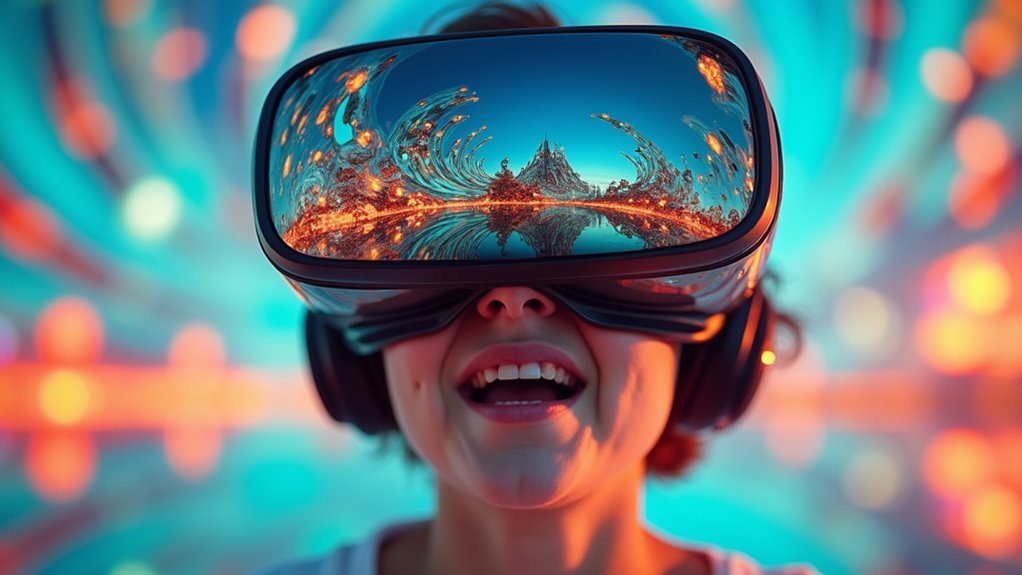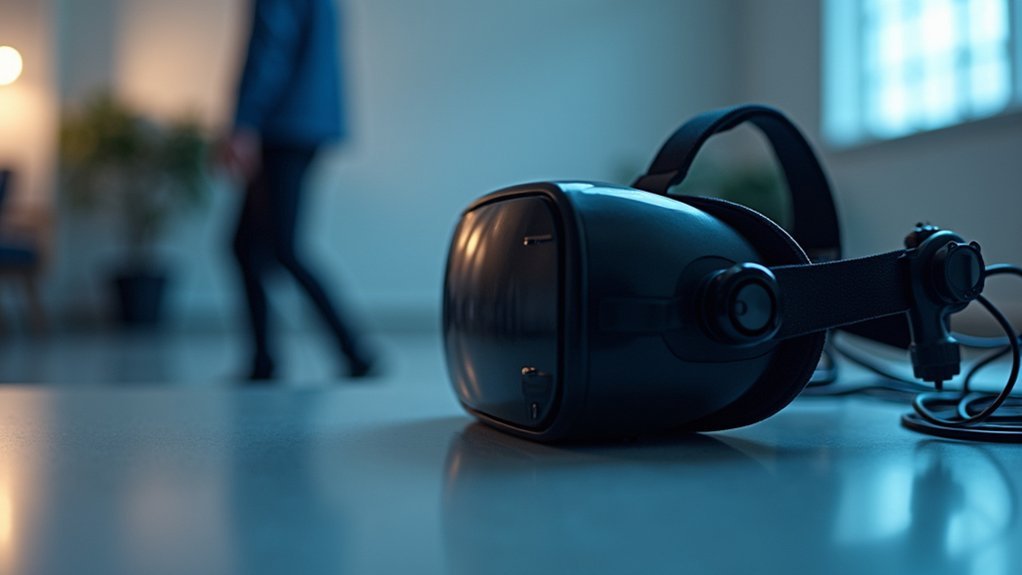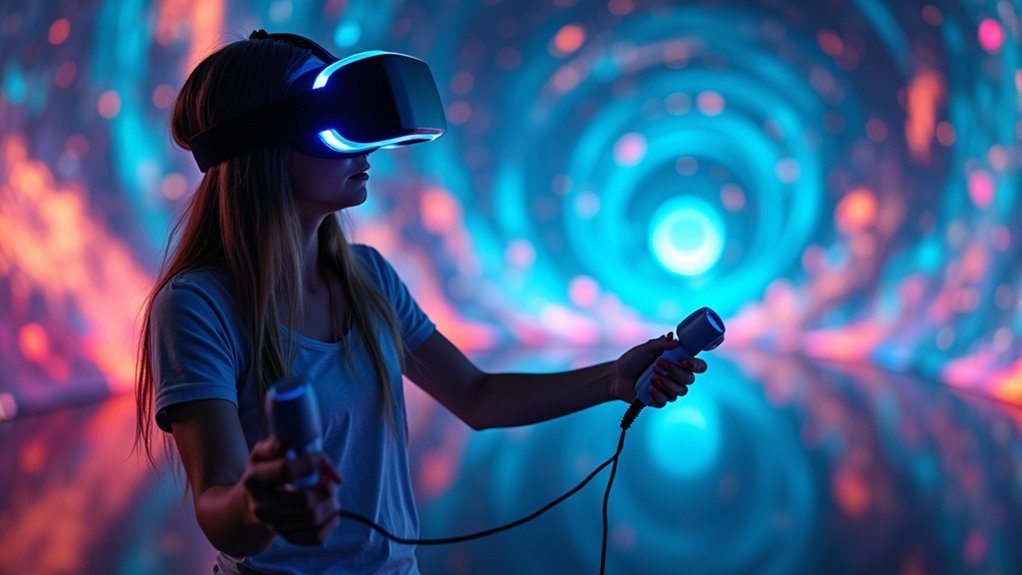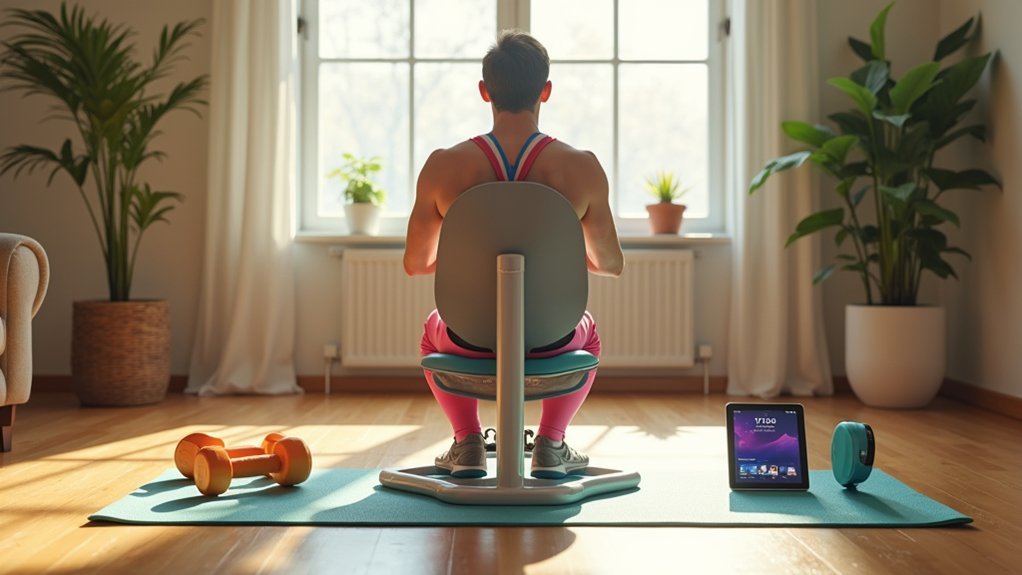You’ll experience balance problems in VR when your eyes perceive movement in virtual environments while your vestibular system senses you’re actually stationary, creating conflicting sensory signals that confuse your brain’s balance mechanisms. Dynamic backgrounds and moving visual elements worsen this effect by increasing postural sway and instability. Hardware factors like poor tracking, high latency above 20 milliseconds, and low frame rates below 90 FPS compound these issues, while your individual susceptibility depends on age, pre-existing conditions, and VR familiarity—factors that determine the severity of your symptoms.
Sensory Conflict Between Visual and Vestibular Systems

When you enter a virtual reality environment, your brain receives conflicting signals that can throw off your balance and make you feel disoriented.
Virtual reality tricks your brain by sending mixed signals that disrupt your natural sense of balance and spatial awareness.
This sensory conflict occurs because your eyes process visual inputs showing movement through virtual spaces, while your vestibular system detects that you’re actually standing still. Your brain expects these two sensory systems to provide matching information about your body’s position and movement.
When they don’t align, your brain struggles to determine what’s real. This mismatch triggers your body’s natural response to conflicting sensory data, often resulting in motion sickness symptoms like nausea and dizziness.
The disconnect between what you see and what your inner ear feels creates an unsettling experience that disrupts your normal balance mechanisms.
Impact of Dynamic Moving Backgrounds on Postural Stability
As dynamic backgrounds shift and move in virtual reality environments, they create an additional layer of visual stimulation that considerably disrupts your postural stability.
When you’re immersed in VR with moving backgrounds, your body experiences considerably increased postural sway compared to static environments. This disruption manifests through higher sway velocity and length, making you feel unstable and uncomfortable.
The moving visual elements confuse your balance system, leading to elevated eye fatigue and dizziness scores. These balance issues directly contribute to motion sickness symptoms that can quickly ruin your VR experience.
Research consistently shows that dynamic backgrounds exacerbate stability problems, which is why developers should prioritize fixed-background designs.
Hardware Factors That Affect Balance Perception

Beyond environmental factors, your VR headset’s technical specifications directly influence how well you maintain balance during virtual experiences.
Hardware factors play an essential role in determining your stability. VR headsets with 6DoF tracking provide superior spatial awareness compared to 3DoF models, which offer limited movement detection.
Latency creates significant balance challenges when delays occur between your head movements and the system’s response. This disconnect between visual and vestibular cues disrupts your body’s natural balance mechanisms.
When your VR headset’s response lags behind your head movements, the mismatch between what you see and feel disrupts natural balance control.
Your headset’s field of view also matters considerably – narrower views increase sensory conflicts and postural sway.
Frame rates below 90 FPS cause visual glitches that worsen balance problems.
Additionally, proper headset fit remains vital, as misaligned visual cues from poor adjustment directly impact your balance perception and overall comfort.
Frame Rate and Visual Latency Effects on Equilibrium
When your VR headset can’t maintain at least 90 FPS, you’ll experience noticeable lag that creates a jarring disconnect between what you see and how you move.
This visual delay confuses your brain as it struggles to process the mismatch between your actual movements and the delayed visual response on screen.
You’ll find yourself swaying more and having trouble maintaining balance as your body fights to reconcile these conflicting sensory inputs.
Low Frame Rates
While your brain relies on seamless visual feedback to maintain balance, low frame rates in VR can shatter this delicate coordination and leave you struggling to stay steady.
When your headset drops below the recommended 90 FPS, visual latency creates a problematic lag between your movements and what you see. This disconnect confuses your brain’s motion interpretation, disrupting the synchronization between visual input and vestibular feedback.
You’ll experience increased postural sway as your body struggles to process conflicting signals. The inconsistent visual feedback from inadequate frame rates triggers oculomotor distress, making equilibrium nearly impossible to maintain.
Studies show approximately 25% of users develop VR motion sickness from insufficient frame rate performance, with symptoms including dizziness and disorientation that directly compromise your ability to stay balanced.
Visual Delay Impact
Visual delay creates a devastating cascade effect that throws your equilibrium into chaos, as even milliseconds of lag between your movements and the virtual display can trigger severe balance disruption.
When your VR system’s frame rate drops below 90 FPS, your brain can’t properly synchronize visual feedback with your physical movements, creating postural instability that leaves you swaying and disoriented.
Visual latency above 20 milliseconds becomes particularly problematic, confusing your vestibular system that depends on perfectly timed sensory inputs.
You’ll experience increased postural sway as your body struggles to maintain balance against delayed visual cues.
This disconnect between what you’re doing and what you’re seeing amplifies motion sickness symptoms, making fast-paced VR environments especially challenging for maintaining your equilibrium.
Field of View Limitations and Spatial Disorientation

Although modern VR headsets have made significant advances in display technology, their field of view limitations continue to create substantial balance problems for users.
When your headset’s field of view doesn’t match your natural vision, it restricts vital peripheral visual information that your body relies on for maintaining balance and orientation. This mismatch creates a disconnect between what you’re seeing and your vestibular system’s signals, leading to spatial disorientation.
Ironically, increasing the field of view can worsen balance issues by triggering simulator sickness. Rapidly changing visuals or movement within these immersive environments confuse your brain’s spatial processing, making it difficult to maintain proper orientation.
Your peripheral vision normally provides essential balance cues, so when VR systems can’t adequately replicate this natural input, disorientation and balance difficulties inevitably follow.
Prolonged VR Exposure and Balance Deterioration
When you spend extended periods in VR environments, you’ll notice your balance becomes progressively worse with each passing minute.
Your body’s postural control systems start breaking down as conflicting signals between what you see and what your inner ear senses create mounting instability.
This cumulative effect means you can’t simply ignore the duration of your VR sessions if you want to maintain steady footing.
Extended Session Effects
As you spend more time immersed in virtual environments, your balance gradually deteriorates due to the mounting sensory conflict between what your eyes perceive and what your inner ear detects. Extended VR sessions greatly worsen motion sickness symptoms, creating a cascade of dizziness and disorientation that directly impacts your stability.
| Session Duration | Balance Impact |
|---|---|
| 0-30 minutes | Minimal postural sway |
| 30-60 minutes | Moderate instability |
| 1-2 hours | Significant balance problems |
| 2+ hours | Severe deterioration |
Research confirms that longer VR experiences produce more pronounced changes in postural stability. You’ll likely notice increased swaying and difficulty maintaining steady footing as your session progresses. These effects mirror traditional motion sickness patterns, with symptoms potentially lingering for hours after you’ve removed your headset.
Cumulative Stability Loss
Beyond single session impacts, repeated VR exposure creates a compounding effect where your balance stability progressively worsens over time.
This cumulative stability loss occurs because your brain struggles to reconcile conflicting signals between visual input from the virtual environment and vestibular feedback from your inner ear. Each VR session adds to this sensory confusion, resulting in increased postural sway that carries over between sessions.
You’ll notice higher sway velocities and greater difficulty maintaining static balance after extended use.
Moving backgrounds in VR environments accelerate this deterioration, causing more severe dizziness and eye fatigue.
These symptoms often persist even after you remove the headset, creating lingering disorientation that can affect your daily activities and overall balance confidence.
Individual Susceptibility Factors to VR Balance Issues
While virtual reality affects everyone differently, certain demographic and physiological factors make some users more prone to balance issues than others.
Understanding your individual susceptibility can help you prepare for and manage VR experiences more effectively.
Knowing your personal risk factors allows you to better prepare for and successfully navigate virtual reality experiences.
Key factors that influence your vulnerability to VR balance problems include:
- Age demographics – If you’re between 2-12 years old or over 50, you’ll likely experience increased susceptibility to VR-induced balance difficulties.
- Gender differences – Women may face higher rates of VR motion sickness and balance issues, though research shows mixed results.
- Medical history – Previous motion sickness, inner ear disorders, or migraines increase your risk of balance problems.
- Cognitive factors and postural instability – Your familiarity with VR technology and natural balance abilities considerably affect adaptation speed.
Age-Related Differences in VR Balance Response
Your age greatly influences how your body responds to virtual reality balance challenges, with distinct patterns emerging across different life stages.
If you’re between 2 and 12 years old, you’re at heightened risk for VR-induced balance problems because your vestibular systems are still developing.
As a young adult past 21, you’ll typically show decreased susceptibility to these issues.
However, if you’re over 50, you’ll likely experience increased VR motion sickness and balance instability again.
These age-related differences stem from variations in your sensory processing abilities.
Older adults often face compromised postural stability in VR environments, experiencing greater postural sway, dizziness, and disorientation that can increase fall risks during virtual experiences.
Standing vs. Sitting Positions During VR Use
Understanding how age affects your VR balance response leads to another important consideration: whether you stand or sit during virtual experiences greatly impacts your stability and comfort.
Standing during VR use creates greater postural demands and increases your risk of balance problems. You’ll likely experience more motion sickness and dizziness when standing, as the disconnect between perceived movement and actual body position becomes more pronounced.
Research shows standing participants encounter heightened postural sway and instability.
Here are four key differences between positions:
- Standing increases motion sickness due to greater postural instability
- Sitting provides better balance with a stable base of support
- Standing amplifies disorientation from visual-vestibular conflicts
- Sitting enables gradual VR acclimation for building tolerance safely
Eye Fatigue and Its Connection to Balance Problems
When you spend extended time in VR, your eyes work overtime to process conflicting visual information while your vestibular system sends different balance signals, creating a sensory mismatch that confuses your brain.
Your oculomotor system strains as it constantly adjusts focus and tracks virtual objects, leading to fatigue that directly impacts your body’s ability to maintain equilibrium.
This eye strain disrupts your postural stability by compromising the visual feedback your brain relies on to keep you balanced in both virtual and physical space.
Visual-Vestibular Signal Mismatch
As you immerse yourself in virtual reality, your brain struggles to reconcile conflicting signals from your eyes and inner ear, creating a sensory battlefield that can leave you dizzy and unsteady.
This visual-vestibular mismatch happens when your eyes perceive movement in the virtual world while your inner ear detects no corresponding motion. Your balance system becomes confused, leading to increased postural sway and instability.
Key effects of visual-vestibular conflict include:
- Immediate dizziness – Your brain can’t process the contradictory movement signals
- Increased postural sway – Particularly noticeable with moving VR backgrounds
- Diminished proprioceptive awareness – Eye strain reduces your body’s spatial awareness
- Prolonged instability – Effects can persist even after removing the headset
This sensory disconnect becomes worse with eye strain, creating a cycle where visual fatigue amplifies balance problems.
Oculomotor System Strain
While visual-vestibular conflicts trigger immediate balance problems, your eyes bear an additional burden that compounds these stability issues.
Your oculomotor system works overtime during VR sessions, constantly adjusting focus and tracking rapid visual changes. This strain leads to eye fatigue, blurred vision, and difficulty focusing—symptoms that directly impair your brain’s ability to process visual information accurately.
When your visual system can’t function properly, it disrupts the critical role vision plays in maintaining postural stability. The resulting disconnect between what you see and what your inner ear senses worsens motion sickness and balance problems.
Without regular breaks, this cumulative strain on your oculomotor system progressively impairs motor coordination, making you more susceptible to dizziness and stability issues throughout your VR experience.
Postural Stability Disruption
Since your oculomotor system can’t keep up with VR’s demands, your body’s postural stability begins to deteriorate in measurable ways.
When your eyes struggle to process conflicting visual information, your balance suffers markedly.
Eye fatigue creates a cascade of postural problems that researchers can measure:
- Increased sway velocity – Your body rocks back and forth more markedly as your visual system fails to provide stable reference points.
- Heightened VR sickness symptoms – Blurred vision and discomfort disrupt your vestibular system’s coordination abilities.
- Moving background sensitivity – Dynamic environments amplify eye strain, making balance control nearly impossible.
- Visual-vestibular disconnect – Your eyes see movement that doesn’t match actual head position, causing disorientation.
Fixed-background VR experiences markedly reduce these postural disruptions, proving that stable visual references are essential for maintaining balance during virtual reality use.
Motion Tracking Accuracy and Postural Feedback
When you step into a virtual reality environment, your balance depends heavily on how accurately the system tracks your movements and translates them into visual feedback.
Motion tracking accuracy is vital because even tiny delays or errors create mismatches between what you see and feel, directly causing balance problems.
Your brain relies on postural feedback from the VR system to understand your body’s position and orientation. When tracking latency exceeds 20 milliseconds, you’ll experience significant stability issues. This delay creates sensory conflict between your visual perception and physical sensations.
Even minimal tracking delays beyond 20 milliseconds create sensory conflicts that directly disrupt your balance and spatial awareness in VR.
Motion controllers can help reduce these problems by letting you visually track your hand movements, providing additional reference points.
Proper system calibration and optimization are essential for minimizing postural instability and ensuring smoother VR experiences.
Virtual Environment Design Impact on Stability
Beyond tracking accuracy, the actual design of virtual environments plays an essential role in how well you maintain your balance. The visual elements and spatial cues within VEs directly influence your postural stability, often creating unexpected challenges that wouldn’t exist in real-world settings.
Key factors affecting your balance in virtual environments include:
- Moving backgrounds – These create considerably more postural sway compared to static scenes.
- Unfamiliar visual stimuli – Novel spatial cues can trigger sensory conflicts that worsen balance issues.
- Absence of reliable visual references – This mimics eyes-closed conditions, reducing stability.
- Fixed reference points – Including these design elements helps anchor your balance and reduces motion sickness.
Understanding these design principles helps developers create more comfortable VR experiences.
Pre-existing Conditions That Worsen VR Balance Issues
While virtual reality balance challenges affect everyone to some degree, certain pre-existing medical conditions can greatly amplify these problems.
If you have pre-existing vestibular disorders, VR’s conflicting sensory inputs will likely worsen your spatial orientation difficulties considerably. Your history of motion sickness also puts you at higher risk, since you already have lower sensory conflict thresholds that make disorientation more likely.
Neurological conditions like migraines increase your sensitivity to VR’s sensory stimuli, creating additional balance complications.
Age-related balance impairments become particularly problematic if you’re over 50, as natural declines in proprioception compound VR’s destabilizing effects.
Cognitive impairments from conditions like ADHD or dementia further complicate your brain’s ability to process virtual environments, leading to increased discomfort and stability issues.
Frequently Asked Questions
Can VR Mess up Your Equilibrium?
Yes, VR can mess up your equilibrium by creating sensory conflicts between what you’re seeing and your inner ear’s balance signals, causing dizziness, nausea, and increased postural sway.
How to Get Rid of VR Vertigo?
Start with shorter 5-10 minute sessions and gradually increase duration. Sit down while playing, make certain your headset fits properly, choose slower-moving VR experiences, stay hydrated, and avoid heavy meals beforehand.
Why Do I Get Dizzy When Playing VR?
You get dizzy playing VR because your eyes see movement while your inner ear senses you’re stationary. This sensory mismatch confuses your brain, triggering dizziness and motion sickness symptoms.
Can VR Cause Neurological Problems?
VR can cause neurological problems if you’re predisposed to conditions like migraines or inner ear disorders. Extended use without breaks may lead to persistent visual strain, balance issues, and temporarily altered spatial awareness.





Leave a Reply